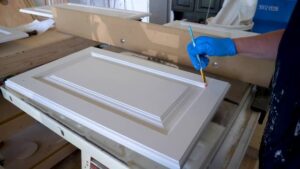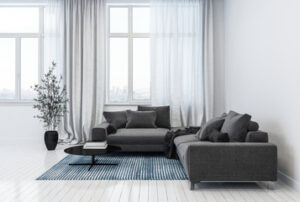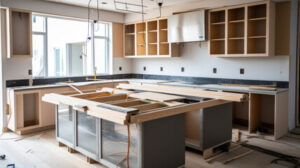Cabinet Refinishing Modesto Anchor is a way to upgrade your kitchen without ripping out existing cabinetry. It typically involves staining or painting cabinetry.

The process requires careful paint application and often includes several coats, sanding between each. It can also include cleaning using chemical products like trisodium phosphate (TSP) and soap and water.
Whether your cabinets are worn, outdated, or simply in need of a facelift, refinishing them is an economical and environmentally responsible option. Unlike cabinet refacing, refinishing can be completed in a shorter time frame, typically within a week or two. The process involves using paint or stain to refresh the existing cabinets’ appearance. The goal is to create a look that is customized and modern. This may include changing the color from light to dark, or a light color to a darker shade. Cabinet refinishing can also be used to repair or cover scratches, dents and fading.
The first step in the refinishing process is to clean all surfaces of your cabinets. This is a critical step that is often skipped by many contractors, but is very important for long-lasting results. This is because dirt acts like a barrier, preventing the product from properly adhering to the surface. Cleaning the cabinets will also ensure that any old stain or paint is removed, allowing for a smooth, even finish.
After cleaning, the surfaces should be sanded to provide a smooth base for new coatings. This should be done with medium-grit sandpaper, and the surfaces should be wiped down again to remove any dust.
Next, you’ll want to apply a coat of primer, and allow it to dry completely. It’s important to choose a high-quality primer, such as Zinnser Oil-Based Primer, to prevent the new finish from chipping or peeling prematurely. Once the primer is dry, you can begin the sanding and painting process.
It’s a good idea to use plastic sheeting and drop cloths to protect your floors, walls, and countertops from any paint or stain spills. Stains and paints contain volatile organic compounds that can irritate the skin, eyes, nose, and throat. You’ll also need to wear personal protective gear and have adequate ventilation when working with these products.
When refinishing cabinets, it is important to note that the original doors aren’t usually made from solid wood. The gable ends, cabinet boxes, and styles were more frequently constructed of real hardwood, but many manufacturers now use cheap veneers to save money. This type of material is not as durable, and it can easily warp or swell from exposure to water.
Primer
The right primer preps the cabinet surfaces and creates a strong base for paint. Primers are “sticky” and specially formulated to adhere well to the surface they’re painted on, which helps the new coat of paint stay put. They also fill in tiny imperfections, creating a flawless canvas that resists chipping and fading.
Whether you’re painting cabinets to freshen the look or for a total makeover, the proper application of primer will ensure your project goes as planned and looks great. Many DIYers skimp on this step, but it’s essential for a beautiful finish that holds up to daily wear and tear and moisture.
Before you can apply the first coat of primer, clean the cabinets with a degreaser solution or trisodium phosphate (TSP). These stronger cleaners are available at hardware stores and paint supply shops and require special protective gear and ventilation.
A good quality primer will hide stains, unwanted odors, water and fire damage, tanning, and knots in the wood. If your cabinets are heavily stained, choose a stain-blocking primer to seal the existing color and prevent it from bleeding through the topcoat. For most refinishing projects, however, an adhesion primer should work fine.
Oil-based primers offer the best durability, but they produce noxious fumes and need to be used in well-ventilated areas with appropriate respirator protection. A water-based primer such as KILZ 3 Premium Primer is an excellent alternative, with low odor and easy cleanup.
Regardless of which type of primer you use, always follow the manufacturer’s instructions for thinning. The can label may say no thinning required, but it’s important to thin the primer with mineral spirits for brushable or sprayable viscosity.
After the primer dries, you can sand it lightly to smooth the surface and eliminate any bumps or uneven textures. If necessary, you can apply a second coat of primer for the perfect finish.
When the final primer dries, it’s time to paint! If you’re not re-staining the cabinet doors or drawer fronts, choose an acrylic latex paint that dries quickly and offers outstanding adhesion. If you’re re-staining the cabinet doors and drawer fronts, you can select an oil-based or shellac-based primer with good durability and stain-blocking qualities.
Stain
Once all of the safety precautions are taken care of, and your work area is prepped for staining, you’re ready to begin. Start by removing all knobs, handles, and hinges from your cabinets. Make sure you mark each one with a letter on painter’s tape so they are easy to reattach when you’re done. This is also a good time to clean your cabinet doors. Make sure to scrape off any food residue, then scrub the surfaces with synthetic steel wool and soapy water. If the cabinets are especially greasy, you can use trisodium phosphate (TSP) to help break up and dissolve grease.
Once the cabinets are clean, you’re ready to sand them down to prepare them for staining. Depending on your preference, you can choose from gel stains, traditional stains, or stain/sealer in-one formulas. Gel stains are a great choice for those who want to go from light to dark and don’t want to undergo the hassle of chemical stripping. However, they still require some light sanding to minimize raising of the grain.
Traditional stains soak deep into wood, highlighting its natural grain and providing rich color tones. This option can be tricky on textured or molded surfaces, though. Before beginning the staining process, sand the cabinets with medium-grit sanding sponges or 180-grit sandpaper on a random orbital sander. This roughing up of the surface will give it “tooth” and improve the adhesion of the new finish.
Before you start applying your stain, make sure to test it on a small area of the cabinet door. This will ensure that the color and consistency of the stain will match your preferences and the condition of the cabinet. Once you’re satisfied with the results, you can move on to the next step.
Before you apply the stain, make sure that your cabinet doors are completely dry from sanding and painting. To speed up this process, you can use a cabinet-safe quick-dry primer. Follow the manufacturer’s instructions for application. After the primer has dried, you can apply a coat of stain. Allow it to penetrate and dry before wiping it off with a soft cloth.
Finish
Cabinet refinishing involves keeping all of the components in your cabinetry, and only changing their color. This can be accomplished by using chemical strippers or lots of hand sanding to remove any existing paint or stain from the wood, then applying new color with a brush or sprayer. Before you can stain your cabinets, they should be sanded and patched with wood filler as needed. You will also want to use an adhesion-promoting primer to create a smooth primed surface.
Choose your stain color from a variety of options, and apply coats to your cabinets, with at least one light sanding between each. It’s best to use a brush for application, but you can also opt to spray. Once the stain has dried, you can reinstall your cabinets.
If you’re not happy with the look of your kitchen, refinishing your cabinets can give you an updated look for a fraction of the cost of replacing them. Plus, refinishing is environmentally friendly, since you’re reducing the amount of wood that ends up in landfills.
On the other hand, refacing is a much more extensive project than refinishing. In addition to removing all of your existing doors and drawer fronts, you’ll need to replace the cabinet hinges, and maybe even the knobs and pulls. This can add up quickly, making refacing a more expensive option.
While refacing can be done by yourself, it’s typically recommended that you work with a professional who is familiar with the process and the tools required. A professional can help you select the right materials for your cabinetry, and also ensure that the job is completed correctly, with minimal mistakes.
Cabinet refacing can also be done by yourself, but you’ll need to purchase a veneer kit, which will include wood veneers and application materials. If you’re refacing your own cabinets, follow the manufacturer’s instructions to attach the veneer panels to the face frames and side panels of your cabinets. Using a utility knife, trim the edges and overhang of the veneer panels to fit perfectly. Then, you can reinstall your new cabinet hardware and enjoy your brand new kitchen!


